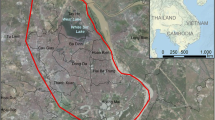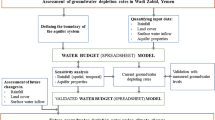Abstract
Groundwater overexploitation is threatening our ecosystems and even the life of future generations. Once happens, elimination of the bad influence will be a long-term process. It should be a feasible approach to take the environmental recovery as a whole by the way of the groundwater management. A case study of water resources management in Huaibei city, within semiarid region of north Anhui province, China, was illustrated, especially on the issues of groundwater over-extraction drawdown funnel recovery. Taking into account the water demand for satisfying the urban development in the next 15 years, three target years of water resources planning were postulated as the present (2005), the short-term (2010) and the long-term (2020), respectively. Four hydrological years: wet year, mean year, dry year and extremely dry year, were also defined by the rainfall data for many years. A groundwater management model which could deal with twelve possible scenarios (3 target years of water resources planning ×4 hydrological years) was established based on simulation and optimization. The groundwater management model could optimize the strategies of water resources development, integrate various kinds of water sources, e.g. groundwater, surface water and additive water sources, and meet the water demand for the urban development within an area of Huaibei city. Importantly, in accordance with the groundwater management model solutions, the issues of groundwater over-extraction drawdown funnel, which has formed within the Huaibei downtown area for many years and lead to some environmental and social problems, would be solved over the whole planning period.










Similar content being viewed by others
References
Anhui Institute of Water Research (2002) Planning of urban water resources of Huaibei city, Anhui province. Water bureau in Huaibei, Anhui province, China
Barlow PM, Ahlfeld DP, Dickerman DC (2003) Conjunctive-management models for sustained yield of stream aquifer systems. J Water Resour Plan Manag 129(1):35–48
Cosgrove DM, Johnson GS (2004) Transient response functions for conjunctive water management in the Snake River Plain, Idaho. J Am Water Resour Assoc 40(6):1469–82
Deninger RA (1970) System analysis of water supply system. Water Resour Bull 6(4):573–9
Gorelick SM (1983) A review of distributed parameter groundwater management modelling methods. Water Resour Res 19(1):305–19
Gorelick SM (1990) Large-scale non-linear deterministic and stochastic optimization: formulations involving simulation of subsurface contamination. Math Program 48:19–39
Heidari M (1982) Application of linear systems theory and linear programming to groundwater management in Kansas. Water Resour Bull 18:1003–12
Liu CW, Chou YL, Lin ST (2010) Management of high groundwater level aquifer in the Taipei Basin. Water Resour Manag 24:3513–25
Maddock T III (1972) Algebraic technological function from a simulation model. Water Resour Res 8(1):129–34
Maddock T III (1974) Non-linear technological functions for aquifers whose transmissivities vary with drawdown. Water Resour Res 10(3):877–81
Mc Donald MG, Harbaugh AW (1988) A modular three-dimensional finite-difference ground-water flow model. U. S. Geological Survey Techniques of Water Resources Investigations. Book 6, Chap. A1: pp 586
Morel-Seytoux HJ, Daly CJ (1975) A discrete kernel generator for stream-aquifer studies. Water Resour Res 11(2):253–60
Pruneda EB, Barber ME, Allen DM (2010) Use of stream response functions to determine impacts of replacing surface-water use with groundwater withdrawls. Hydrogeol J 18(5):1077–92
Psilovikos A (1999) Optimization models in groundwater management, based on linear and mixed integer programming. An application to a Greek Hydrogeological basin. Phys Chem Earth B 24(1–2):139–44
Psilovikos A (2006) Response matrix minimization used in groundwater management with mathematical programming: a case study in a transboundary aquifer in northern Greece. Water Resour Manag 20:277–90
Theodossiou N (2004) Application of non-linear simulation and optimization models in groundwater aquifer management. Water Resour Manag 18:125–41
Todd DK, Mays LW (2005) Groundwater hydrology, 3rd edn. John Wiley & Sons, NJ, p 636
Wang GL, Jiang B, Cao DY, Zou H (1998) On the Xuzhou-Suzhou arcuate duplex-imbricate fan thrust system. Acta Geol Sin 72(3):228–36
Waterloo Hydrogeologic (2000) Visual MODFLOW v3.0 user manual. Waterloo Hydrogeologic, Waterloo
Wu Q, Zhou WF, Li D (2006) Management of karst water resources in mining area: dewatering in mines and demand for water supply in the Dongshan Mine of Taiyuan, Shanxi Province, North China. Environ Geol 50(8):1107–17
Wu Q, Zhu B, Liu SQ (2011) Flow-solid coupling simulation method analysis and time identification of lagging water-inrush near mine fault belt. Chin J Rock Mech Eng 30(1):93–105
Zhu B, Wu Q (2005) Application of wall boundary in visual MODFLOW to simulate faults and its practice. J Hunan Univ Sci Technol 20(2):19–25
Acknowledgments
This work was supported by the Bureau of Water Conservancy in Huaibei city.
Author information
Authors and Affiliations
Corresponding author
Additional information
Foundation Item
Supported by Key Laboratory of Geological Engineering Centre of Guangxi
Rights and permissions
About this article
Cite this article
Zhu, B. Management Strategy of Groundwater Resources and Recovery of Over-Extraction Drawdown Funnel in Huaibei City, China. Water Resour Manage 27, 3365–3385 (2013). https://doi.org/10.1007/s11269-013-0352-x
Received:
Accepted:
Published:
Issue Date:
DOI: https://doi.org/10.1007/s11269-013-0352-x




